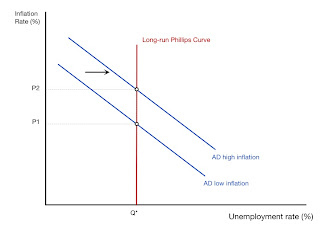From short run to long run
»»AS curve doesn't shift in response to changes in the AD curve in the short runI.e. -nominal wages doesn't respond to price level wages
- workers may not realize impact of the changes on may be under contract
»» long run - period in which nominal wages are fully responsive to previous changes in price level
-when changes occur in the short run they result in either increased our decreased producer profits -not changes in wages paid
-in the long run increases in AD result in a higher price level, as in the short run, but as workers demand more money the AS curve shifts left to equate production at the original output level, but now at a higher price
- in the long run, the AS curve is vertical at the natural rate of unemployment (NRU), or full employment (FE) level of output. Everyone who wants a job has one and no one is enticed then into or out of the market.
- demand - pull inflation will result when an increase in demand shifts the AD curve to the right temporarily increasing output while raising prices
- cost-push inflation results when an increase in input costs that shifts the AS curve to the left. In this case the price level increase is not in response to the increase in AD, but instead the cause of price level increasing
»» the Phillips curve
Represents the relationship between unemployment and inflationThe trade off between inflation and unemployment only occurs in the short run
Each point on the Phillips curve corresponds to a different level of output
»Long run Phillips curve (LRPC)
-It occurs at the natural rate of unemployment-It is represented by a vertical line
-There is no trade off between unemployment and inflation in the long run
-The economy produces at the full employment output level
-The nominal wages of workers fully incorporate any changes in price level as wages adjust to inflation over the long run
-LRPC will only shift if LRAS curve shifts
Because of the long run Philips curve exists at the natural rate of unemployment (NRU), structural changes in the economy that effects UN structural changes in the economy that effects UN will also cause the LRPC to shifts
-increase UN shift LRPC >
-decrease UN shift LRPC <
-The three of unemployment that make up LRPC
Frictional
Structural
Seasonal
» the short run Philips curve (SRPC)
-Phillips is assumed to be stable in the short run because the SRAS curve is stable-If there is an increase our decrease in AD you shift up or down along the SRPC
- if SRAS increases it will shift to the right, but the SRPC with shift to the left
- if SRAS decreases it will shift to the left, but the SRPC will shift to the right
»» supply shocks
-rapid and significant increase in resource cost which causes the SRAS curve to shift this producing a corresponding shift in the short run PC curve»» misery index
-a combination of inflation and unemployment in any given year-single digit mystery is good
» stagflation occurs when high unemployment and high inflation happens at same
»disinflation when inflation decrease over time
» supply- side economics or reagonomics
-support policies that promote GDP growth by arguing that high marginal tax rates along with current system of transfer payments price discentives to work, invest, innovate, and underage entrepreneurial ventures- the supply side economist tend to believe that the AS curve shifts to the right thus creating the trickle down effect
»» meaningful tax rates
-amount proof on the last dollar earned it on each additional dollar earned-by reducing marginal tax rates supply sides believe that you would encourage more people to work longer foregoing leisure time for extra income
»»laffer curve
-Trade offs between tax rates and tax revenues- 3 criticism
-where the economy is actually located in the curve is difficult to determine
-tax cuts also increase demand which can fuel inflation
- empirical evidence suggest they impact of tax rates on incentives to work, invest, and save are small
>>Economic Growth and Productivity
- Economic Growth Defined
- Sustained increase in Real GDP over time
- Sustained increase inReal GDP per Capita over time
- Why Grow?
- Growth leads to greater prosperity for society
- Lessens the burden of scarcity
- increases the general level of well-being
- Conditions of Growth
- Rule of Law
- Sound legal and Economic Institutions
- Economic Freedom
- Respect for Private Property
- Political and Economic Stability
- Low inflationary Expectations
- Willingness to sacrifice current consumption in order to grow
- Saving
- Trade
- Physical Capital
- Tools, machinery, factories, infrastructure
- Physical Capital is the product of investment
- Investment is sensitive to interest rates and expected rates of return
- It takes capital to make capital
- capital must be maintained
- Technology and productivity
- Research and development, innovation and invention yield increases in available technology
- More technology in the hands of workers increase productivity
- Productivity is output per worker
- More Productivity = economic growth
- Human Capital
- People are a country'e most important resource. Therefore human capital must be developed
- Education
- economic freedom
- the right to acquire private property
- incentives
- clean water
- stable food supply
- access to technology
- Hindrances to Growth
- Economic and political instability
- High inflationary expectations
- Absence of the rule of law
- Diminished private property rights
- negative incentives
- the welfare state
- Lack of savings
- excess current consumption
- Failure to maintain existing capital
- Crowding out of investment
- government deficits and debt increasing long term interest rates
- Increased income inequality and populist policies
- Restrictions onFree international Trade
- Economic and political instability


No comments:
Post a Comment